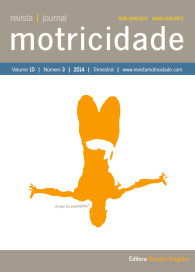Influence of Subcutaneous Fat Layer in Skin Temperature
DOI:
https://doi.org/10.6063/motricidade.5999Resumo
The aim of this study was to determine the correlation between the subcutaneous fat layer and the temperature variation (core - skin) in two body regions, measured by infrared sensors. This study involved 43 volunteers selected among undergraduate students in physical education. The thermal images and skinfold thickness were acquired from subscapular region (SB) for male and triceps region (TR) for female volunteers, of right side. In this study, subscapular skinfold thickness was inversely correlated with skin temperature (r = -0.638, p = 0.004) and directly correlated with ΔT [core – skin] (r = 0.653, p = 0.003). However, the results for the triceps region showed no significant correlation between triceps skinfold thickness and skin temperature or ΔT [core – skin]. When the sample was separated into two groups by skinfold thickness, with cut off at 12mm, average comparison tests for ΔT [core – skin] shows statistically significant difference between groups for the subscapular site (Student t test for independent sample, p value = 0.023), but not for the triceps site (Wilcoxon Signed Ranks and the Mann-Whitney tests, p value = 0.268). In short, the findings suggest that subcutaneous fat layer correlates negatively with skin temperature in subscapular region.
Downloads
Publicado
Edição
Secção
Licença
Os autores dos manuscritos submetidos para publicação deverão ceder, a título integral e permanente, os direitos de autor (copyright) à revista Motricidade e às Edições Sílabas Didáticas. A cedência de direitos de autor permite a publicação e divulgação do artigo em formato impresso ou eletrónico e entrará em vigor a partir da data de aceitação do manuscrito. Os autores concedem, ainda, os direitos para a revista Motricidade utilizar e explorar o respetivo artigo, nomeadamente para licenciar, ceder ou vender o seu conteúdo a bases de resumos/indexação ou outras entidades.
Nos termos da licença “Creative Commons”, os autores poderão reproduzir um número razoável de exemplares para uso pessoal ou profissional, mas sem fins comerciais. Nos termos da licença SHERPA/RoMEO, os autores poderão, ainda, disponibilizar/arquivar uma cópia digital final (versão postprint) do artigo no seu website ou no repositório científico da sua instituição.


